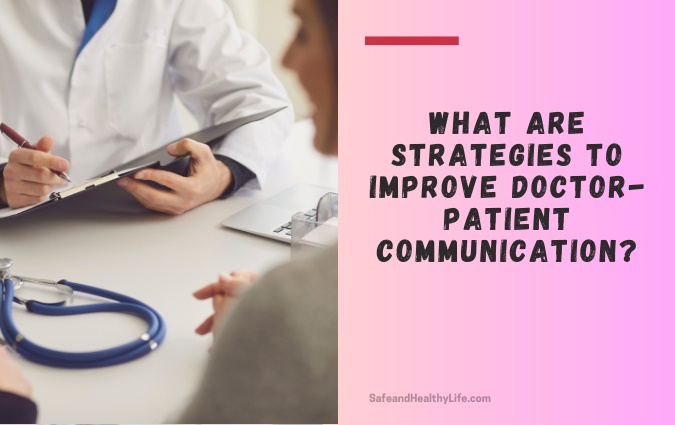
According to a survey conducted by the Physicians Foundation, doctors see about 20 patients per day and spend 51 hours a week at work. It shows that there is a lack of meaningful communication between the doctor and the patient.
Studies also suggest that doctors with effective patient communication skills have a positive impact on the mental health, compliance, and overall satisfaction of the patient. This explains why 65% of medical schools include effective communication skills as a core subject in their curriculum.
Although medical students learn about proper communication tactics with patients but face a hectic routine. They have to look after many patients in a short time. This leaves little room for them to establish an effective communication channel with each patient.
Patients are often left with a list of prescriptions with very limited guidance about their illnesses.
In the real scenario, long hours of work and getting through patient after patient become routine for doctors, and communication with each patient is limited to a few formal words.
Why is communication between a doctor and a patient important?
For a doctor, a small change in tone or choice of words or a few minutes to get to know the patient may seem trivial.
However, for a patient who is struggling through the worst days of his life, these moments can make a difference in the process of his recovery.
So, for those doctors who take time to establish a meaningful conversation with the patients, sit with them and reassure them that they will be with them every step of the way.
These doctors are trusted more by patients because they know that they will be treated as a whole person rather than working on someone’s checklist.
At our medical coding services and dental billing company, we guide you through the process of how the best communication and interaction take place between a doctor and a patient.
You will learn certain useful strategies of communication to not only smooth the conversation but also, get the best treatment at our medical coding services and dental billing company.
What are strategies to improve doctor-patient communication?
The key to establishing confident communication between doctor and patient is empathy. It helps healthcare providers to try to get into the shoes of the patients and understand what their patient is suffering through.
In this regard, it becomes essential for the doctor to listen to the patient and be candid with him. This is so he feels comfortable and shares his feelings.
Here are some of the strategies that can help doctors create a comfortable environment for patients to open up about their situation and establish real-time communication:
Creating an inviting waiting room for patients
Creating a waiting room for your patients can be a vital step to ensure effective communication down the line. An inviting room will comfort the coming patients and expect the quality of practice and service.
Also, train your staff to greet patients well. It can be a warm welcome with greetings, eye contact, or a handshake that makes them feel at ease. A patient is already hesitant to book an appointment and travel to a clinic.
Once your rapport has been developed along with an effective communication channel, ask them about their assumptions or objectives. You should guarantee them your full support at every step.
You can ask them questions like “What were you hoping we would achieve today?” or “Is there something else you would prefer to discuss?”
This conversation will help your team up on a direct path forward. A 2011 study showed that teaming up with the patient did not prolong the visit or the number of issues per visit.
However, it diminished the probability of patients coming up with novel problems, thereby improving doctor-patient communication.
Take care of your meetings with patients.
Considering every meeting with the patient as a priority and not treating it as work will change your attitude toward your availability for the patient. It is crucial to use both verbal and nonverbal communication tools to establish effective communication.
This will make the patient realize that he is being heard properly. Turn your body to face the patient, open your palms, and move your hands.
When this is done, you will make the patient feel that you are committed to the treatment and that you are listening to him.
Comfort the patient with positive words
Conversing with the patient is not always a smooth experience. Doctors have to deal with “bad news” for the patient which often seems difficult to deliver to the patient. In that case, too, doctors must use positive words and point out the positives.
Give them hope by speaking up for them. It is the pinnacle of effective doctor-patient communication.
In most cases, you should use words like “with you” and “for you” regularly. Besides, use appreciation words. Say thank you or a pat on the back. This will help them relieve stress about their illness and motivate them for a speedy recovery.
Similarly, we always try to smooth the communication between the doctor and patient to get fruitful results at our medical coding services. Our skillful team works efficiently to understand the customer’s intention through certain communication skills at our medical coding services and dental billing company.
Ask open-ended questions to initiate the conversation
Asking open-ended questions will give the patient a chance to share his own story in detail. Use phrases like “mention what occurred”, “continue”, or “Help me understand this further”.
This strategy at the initial stage of the visit enables doctors to understand the case and accumulate detailed data.
Once the case is clarified, you can move to close-ended questions that will help fill the gaps in the story and be specific to enhance doctor-patient communication.
Follow the RESPECT Model
While encountering patients from different ethnic and ethnic backgrounds, doctors may become biased without realizing it.
To avoid such practices, the RESPECT model promotes physicians’ awareness of their own cultural biases. It also helps them develop rapport with patients from diverse cultures.
The model includes seven elements that doctors should pay attention to while engaging with patients to establish good doctor-patient communication.
- Rapport
Building a rapport with the patient is critical to building effective doctor-patient communication. Doctors should connect socially and try to understand the patient’s point of view. Avoid judgments at any level and suspend them. This will help the patient share his story without worrying about the doctor’s bias and help initiate a healthy conversation.
- Empathy
It usually happens that doctors go through several patients with similar medical histories so they treat them the same. Although medical histories can be the same, patients can be different individuals with different behaviors. Therefore, doctors should understand the patient’s rationale for his behavior or illness and treat them individually.
- Support
Making a patient realize that you are there for him/her is half the job. The patient is relieved of stress and becomes more confident in her practice as a result. Doctors can also help patients overcome barriers to care and compliance by using different ways such as involving family members when necessary.
- Partnership
Using “we” during practice can be crucial. It stresses that you team up with the patient and are ready to address medical problems together. This partnership helps entrench doctor-patient communication and helps the patient remain motivated to take care of themselves.
- Explanations
Try to keep track of the communication transparent and be clear in explaining the medical condition to the patient.
- Cultural competence
Always respect the patient’s culture and beliefs and don’t allow your bias toward specific cultures to influence your treatment or communication with the patient.
- Trust
Self-disclosure may be an issue for some patients not accustomed to Western medical practices. To establish trust between doctor and patient, consider taking the necessary time to build this communication.
About The Author:
Stacey Smith is a freelance health writer. She is passionate about writing about women’s health, dental health, diabetes, endocrinology, and nutrition and provides in-depth features on the latest in health news for medical clinics and health magazines.


![[Infographic] Establishing A Clear Channel Of Communication In Healthcare Channel-Of-Communication-In-Healthcare](https://www.safeandhealthylife.com/wp-content/uploads/2023/10/Channel-Of-Communication-In-Healthcare-1-150x150.webp)

